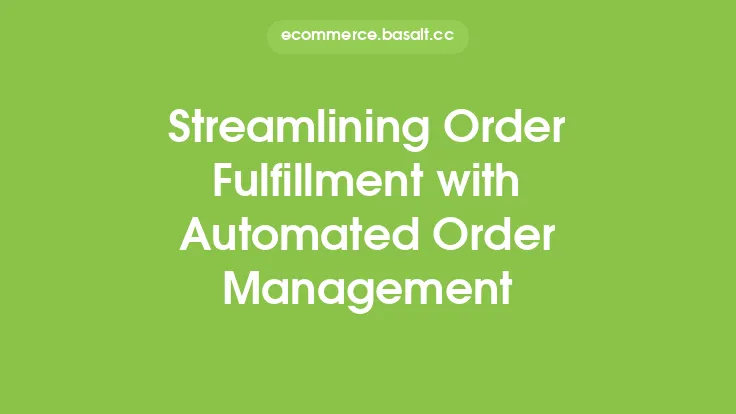In today's fast-paced e-commerce landscape, managing orders efficiently is crucial for businesses to stay competitive and provide excellent customer service. An order management system (OMS) is a software solution designed to streamline and automate the order fulfillment process, from receiving and processing orders to shipping and delivering products to customers. At its core, an OMS is a centralized platform that enables businesses to manage their orders across multiple sales channels, including online marketplaces, social media, and physical stores.
Introduction to Order Management Systems
An order management system is a comprehensive software solution that integrates with various e-commerce platforms, marketplaces, and payment gateways to provide a unified view of all orders. It enables businesses to manage their orders in real-time, making it easier to track inventory levels, process payments, and fulfill orders quickly and accurately. An OMS typically includes features such as order processing, inventory management, shipping and logistics management, and reporting and analytics.
How Order Management Systems Work
An order management system works by integrating with various sales channels and marketplaces to capture orders in real-time. Once an order is received, the OMS processes the order and checks for availability of inventory. If the inventory is available, the OMS allocates the stock and updates the inventory levels. The OMS then generates a shipping label and sends it to the shipping carrier for pickup. The OMS also updates the order status in real-time, enabling customers to track their orders from the time of placement to delivery.
Components of an Order Management System
A typical order management system consists of several components, including order processing, inventory management, shipping and logistics management, and reporting and analytics. The order processing component is responsible for capturing orders from various sales channels and processing them in real-time. The inventory management component tracks inventory levels across multiple warehouses and locations, enabling businesses to manage their stock levels efficiently. The shipping and logistics management component generates shipping labels and sends them to the shipping carrier for pickup. The reporting and analytics component provides insights into order fulfillment, inventory levels, and shipping performance, enabling businesses to make data-driven decisions.
Order Management System Architecture
An order management system architecture typically consists of a centralized database that stores all order information, including customer data, order history, and inventory levels. The database is connected to various sales channels and marketplaces through APIs, enabling the OMS to capture orders in real-time. The OMS also integrates with payment gateways, shipping carriers, and other third-party services to provide a seamless order fulfillment experience. The architecture is designed to be scalable and flexible, enabling businesses to add or remove sales channels and marketplaces as needed.
Order Management System Workflow
The order management system workflow typically involves several steps, including order capture, order processing, inventory allocation, shipping, and delivery. Once an order is captured, the OMS processes the order and checks for availability of inventory. If the inventory is available, the OMS allocates the stock and updates the inventory levels. The OMS then generates a shipping label and sends it to the shipping carrier for pickup. The OMS also updates the order status in real-time, enabling customers to track their orders from the time of placement to delivery. The workflow is designed to be automated and efficient, enabling businesses to fulfill orders quickly and accurately.
Integration with Other E-commerce Systems
An order management system can be integrated with other e-commerce systems, including e-commerce platforms, marketplaces, payment gateways, and shipping carriers. The integration enables businesses to manage their orders across multiple sales channels and marketplaces, providing a unified view of all orders. The integration also enables businesses to automate their order fulfillment process, reducing errors and increasing efficiency. Common integrations include e-commerce platforms such as Shopify and Magento, marketplaces such as Amazon and eBay, payment gateways such as PayPal and Stripe, and shipping carriers such as UPS and FedEx.
Security and Compliance
An order management system must be secure and compliant with various regulations, including PCI-DSS, GDPR, and HIPAA. The OMS must protect sensitive customer data, including credit card numbers and personal identifiable information. The OMS must also comply with regulations related to inventory management, shipping, and logistics. Businesses must ensure that their OMS is secure and compliant, reducing the risk of data breaches and regulatory fines.
Conclusion
In conclusion, an order management system is a software solution designed to streamline and automate the order fulfillment process. It integrates with various sales channels and marketplaces to provide a unified view of all orders, enabling businesses to manage their orders in real-time. The OMS includes features such as order processing, inventory management, shipping and logistics management, and reporting and analytics. It works by capturing orders in real-time, processing them, and fulfilling them quickly and accurately. The OMS architecture is designed to be scalable and flexible, enabling businesses to add or remove sales channels and marketplaces as needed. By understanding how an order management system works, businesses can improve their order fulfillment process, reduce errors, and increase customer satisfaction.





